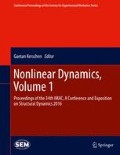Abstract
When a structure is subjected to an extreme environment, its linear normal modes, which are uncoupled under small loads, begin to influence each other and exchange energy. This is easily explained when the nonlinear normal modes of the structure are computed, since they show internal resonances where the underlying linear modes combine to produce the NNM solution at each excitation level. This paper examines the degree to which nonlinear modal coupling can serve as an energy transfer mechanism in order to reduce the vibration levels of a structure subjected to a broadband, random forcing. The structure in question is a beam with an intermediate support that is adjusted in order to vary the frequency ratios between modes. To explore the significance of modal coupling, two types of reduced order models are examined: A customary model including all of the coupling terms between the linear modes, and an uncoupled reduced order model which contains nonlinear stiffness terms in single modes only. The differences in response between the two models are used to quantify the effect of nonlinear modal coupling in the structure.
Access this chapter
Tax calculation will be finalised at checkout
Purchases are for personal use only
References
Gordon, R.W., Hollkamp, J.J.: Reduced-order models for acoustic response prediction. Technical Report, AFRL-RBWP-TR-2011-3040, Air Force Research Laboratory (2011)
Teunisse, N., Tiso, P., Demasi, L., Cavallaro, R.: Computational reduced order methods for structurally nonlinear joined wings. In: 56th AIAA/ASCE/AHS/ASC Structures, Structural Dynamics, and Materials Conference, Kissimmee, FL (2015)
Wang, J., Tzikang, C., Sleight, D.W., Tessler, A.: Simulating nonlinear deformations of solar sail membranes using explicit time integration. In: 45th AIAA/ASCE/AHS/ASC Structures, Structural Dynamics, and Materials Conference, Palm Springs, CA (2004)
Tuegel, E.J., Ingraffea, A.R., Eason, T.G., Spottswood, M.S.: Reengineering aircraft structural life prediction using a digital twin. Int. J. Aerosp. Eng. 2011 (2011)
Nash, M.: Nonlinear structural dynamics by finite element modal synthesis. Ph.D thesis, Department of Aeronautics, Imperial College (1977)
Segalman, D.J., Dohrmann, C.R.: Method for calculating the dynamics of rotating flexible structures, part 1: derivation. Trans. ASME J. Vib. Acoust. 118, 313–317 (1996)
Segalman, D.J., Dohrmann, C.R.: Method for calculating the dynamics of rotating flexible structures, part 2: example calculations. Trans. ASME J. Vib. Acoust. 118, 318–322 (1996)
McEwan, M.I., Wright, J., Cooper, J.E., Leung, A.Y.T.: A combined modal/finite element analysis technique for the dynamic response of a non-linear beam to harmonic excitation. J. Sound Vib. 243, 601–624 (2001)
Muravyov, A.A., Rizzi, S.A.: Determination of nonlinear stiffness with application to random vibration of geometrically nonlinear structures. Comput. Struct. 81, 1513–1523 (2003)
Mignolet, M.P., Przekop, A., Rizzi, S.A., Spottswood, S.M.: A review of indirect/non-intrusive reduced order modeling of nonlinear geometric structures. J. Sound Vib. 332, 2437–2460 (2013)
Hollkamp, J.J., Gordon, R.W., Spottswood, S.M.: Nonlinear modal models for sonic fatigue response prediction: a comparison of methods. J. Sound Vib. 284, 1145–1163 (2005)
Suguang, D., Jensen, J.S.: Optimization of nonlinear structural resonance using the incremental harmonic balance method. J. Sound Vib. 334, 239–254 (2015)
Grappasonni, C., Habib, G., Detroux, T., Wang, F., Kerschen, G., Jensen, J.S.: Practical design of a nonlinear tuned vibration absorber. In: International Conference on Noise and Vibration Engineering, Leuven (2014)
Kerschen, G., Peeters, M., Golinval, J., Vakakis, A.F.: Nonlinear normal modes, part i: a useful framework for the structural dynamicist. Mech. Syst. Signal Process. 23(1), 170–194 (2009)
Nayfeh, A.H.: Introduction to Perturbation Techniques. Wiley, New York (2011)
Rutzmoser, J.B., Rixen, D.J.: Model order reduction for geometric nonlinear structures with variable state-dependent basis. Dyn. Coupled Struct. 1, 455–462 (2014)
Hollkamp, J.J., Gordon, R.W.: Reduced-order models for nonlinear response prediction: implicit condensation and expansion. J. Sound Vib. 318, 1139–1153 (2008)
Allen, M.S., Kuether, R.J., Deaner, B., Sracic, M.W.: A numerical continuation method to compute nonlinear normal modes using modal reduction. In: 53rd AIAA/ASCE/AHS/ASC Structures, Structural Dynamics, and Materials Conference, Honolulu, HI (2012)
Kuether, R.J., Brake, M.R., Allen, M.S.: Evaluating convergence of reduced order models using nonlinear normal modes. Model Validation Uncertain. Quantif. 3, 287–300 (2014)
Dassault Systems Simulia Corp.: Abaqus Theory Manual (2012)
Cook, R.D., Malkus, D.S., Plesha, M.E., Witt, R.J.: Concepts and Applications of Finite Element Analysis, 4th edn. Wiley, New York
Acknowledgements
This material is based upon work supported by the National ScienceFoundation Graduate Research Fellowship under Grant No. DGE-1256259. Anyopinion, findings, and conclusions or recommendations expressed in this materialare those of the authors(s) and do not necessarily reflect the views of the NationalScience Foundation.
The authors also acknowledge Joseph Hollkamp from the Air Force Research Laboratory’s Structural Sciences Center, for the insights that he shared and for providing the Abaqus interface that was used in this work.
Author information
Authors and Affiliations
Corresponding author
Editor information
Editors and Affiliations
Rights and permissions
Copyright information
© 2016 The Society for Experimental Mechanics, Inc.
About this paper
Cite this paper
Schoneman, J.D., Allen, M.S. (2016). Investigating Nonlinear Modal Energy Transfer in a Random Load Environment. In: Kerschen, G. (eds) Nonlinear Dynamics, Volume 1. Conference Proceedings of the Society for Experimental Mechanics Series. Springer, Cham. https://doi.org/10.1007/978-3-319-29739-2_14
Download citation
DOI: https://doi.org/10.1007/978-3-319-29739-2_14
Published:
Publisher Name: Springer, Cham
Print ISBN: 978-3-319-29738-5
Online ISBN: 978-3-319-29739-2
eBook Packages: EngineeringEngineering (R0)

